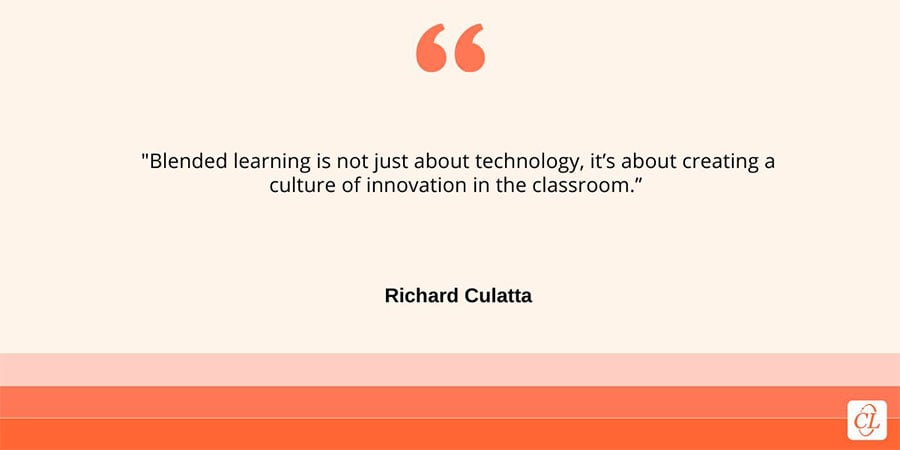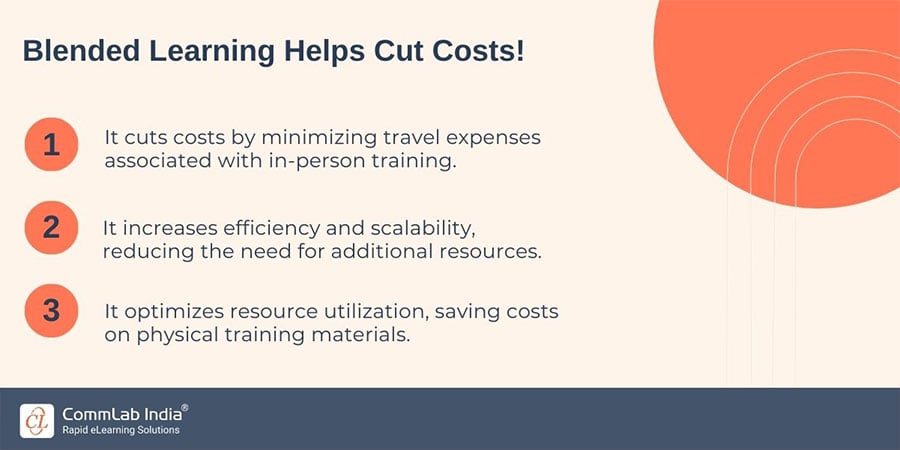5 Reasons Why You Should Adopt Blended Learning to Train Your Modern Workforce!
Blend learning, which is a combination of online and offline, boosts knowledge retention. It is a must for modern corporate training. Let’s explore why!

Blended learning has become a trending buzzword in the corporate world in the post-pandemic digital age. Since 2020, thousands of organizations worldwide have transformed their corporate training strategies to combine multiple offline and online learning methods and technologies for continuous employee development and business growth.
Wondering Why Blended Learning Is The Best For Employee Training?
These 5 reasons may convince you –
- Most Modern Workplaces Have a Multi-Generational Workforce
- Multiple Learning Styles Increase Engagement, Retention, and Knowledge
- Blended Learning Can Control and Optimize the Learning Pace
- Blended Learning Is More Cost-Effective
- Blended Learning Enables Modular Learning/Training at Scale
The rise of digital transformation and hybrid work in modern enterprises has made it crucial for businesses to bridge the gap in skills for emerging technologies. Unfortunately, recruiting skilled and experienced talent is not an ideal or viable solution for everyone, mostly due to financial constraints.
Hence, upskilling and reskilling existing employees provides a quicker and more cost-effective solution to remain relevant and competitive in the highly fluid and volatile business landscape.
But why blended learning?
To answer this question, you need to understand blended learning before learning about its significance for the modern, multi-generational workforce.
Blended Learning Explained

Blended learning is a learner-centric corporate training approach. It combines various offline/online instructor-led and self-paced training methods into a powerful knowledge delivery strategy. These methods include eLearning, ILT/VILT sessions, seminars, and mobile learning.
The core purpose of blended learning is to foster a holistic learning experience for employees in return for increased engagement and participation, better learning outcomes, enhanced productivity, and accelerated career growth, among other benefits.
Blended learning can be applied to almost every work environment, depending on the circumstances and resources available.
Organizations generally use it to combine online learning materials (courses, videos, post-training assessments, etc.) with traditional in-person training environments to give learners the skills and knowledge they need to diversify their capabilities and improve their performances.
Why Is Blended Learning a Must for Today’s Workforce
Blended learning can optimize training for the workforce more efficiently and cost-effectively. It allows organizations to deliver each aspect of training or learning through the most optimal medium and at the ideal pace for different types of learners.
This form of hybrid learning is becoming crucial for corporate training, especially in a rapidly evolving digital economy.
Here’s why:
Most Modern Workplaces Have a Multi-Generational Workforce
The modern workforce comprises multiple generations with different roles and responsibilities. Each generation has varied learning habits, communication styles, goals, and working preferences. As a result, leaders must implement unique strategies to bolster their business goals while accounting for the age diversity in their workforce.
From Baby Boomers to Generation X, Millennials, and Generation Z, each group has different learning needs, capacities, and motivators. For instance, Generation X is more accustomed to traditional classroom sessions. Meanwhile, the more tech-savvy Generation Z grew up with technology and is more attuned to digitalized learning formats and technologies, such as eLearning and virtual instructor-led training sessions.
Therefore, adopting a blended learning approach can allow for more efficiency in delivering training initiatives while ensuring giving every employee group within your organization has the level of comfort they desire.
→ Access Now: Blended Learning to Accelerate Time to Proficiency [Webinar Recording]
Multiple Learning Styles Increase Engagement, Retention, and Knowledge
We learn best when we add and combine multiple learning styles with the more traditional, passive learning style. It can significantly increase learner engagement, subsequently increasing knowledge retention, making us better learners.
You deliver training through different methods when you utilize a blended learning solution’s multiple styles and modules. This ‘blend’ of video, virtual classroom training, social learning, etc can help overcome the knowledge gaps created by a single learning style.
Your workforce can comprehensively understand each topic because knowledge gaps by sub-optimal styles are not left for a particular learner, module, or topic.
Blended Learning Can Control and Optimize the Learning Pace
Most traditional training and learning often fails because it is not paced according to the learner. With a blended learning solution, your workforce has some control over the pace of learning.
This control helps reduce stress and learner apathy and instead motivates the learner. Not only is this good for learning, but it also positively impacts business operations because your workforce is not constantly stressed about their training.
They already have to face competition and manage time between workloads and personal lives. Blended learning allows them to learn online, at a manageable pace, instead of learning at a pace dictated by the slowest or fastest learner around. Additionally, different learning formats such as asynchronomous discussions, webinars, gamified learning, etc can facilitate self-paced learning.
For example in an eLearning session, the learners can take time where they need and speed past areas they are already familiar with. They can also schedule their learning as needed.
Blended Learning Is More Cost-Effective

Regardless of the size and industry of your organization, you can save resources through a hybrid training solution like blended learning. You get a better ROI from increased engagement and retention, and the flexibility and cost savings are profound.
Blended learning allows your business to reduce and save on printing training materials, travel expenses, and instructor fees. It also enables remote learning on a global scale. These savings even include the impact of training on business operations and the workforce.
Through a blended learning solution, companies can half their classroom training hours and split them into web-based e-learning, instructor-led sessions, and remote learning. All this while improving the learning experience of your workforce.
Blended Learning Enables Modular Learning/Training at Scale
The best thing about blended learning is that it is modular and can be scaled upwards and downwards. It can take a while to set up and participate in dedicated classroom training sessions, which makes them expensive in impromptu situations.
On the other hand, an online knowledge base or learning library does not offer enough engagement, feedback, or practice on its own. However, when you combine easily accessible content with occasional practical projects and live instructor-led sessions of a blended learning program, your workforce can quickly learn specific skills.
Modular training or learning courses increase flexibility, increasing your company’s capacity to take advantage of upcoming opportunities. With the rise of remote and hybrid work models, modular blended learning can offer the scalability and personalization needed for companies with a global workforce.
Here’s how you can build a learning curve with blended learning
Wrapping Up
In short, blended learning is a game-changing corporate training strategy designed and optimized to deliver the best results efficiently and cost-effectively. It can achieve this without hurting the workforce, business operations, or company resources. It is modular, personalized, flexible, and scalable, making it the ideal solution for organizations of any size and in any industry. It will improve training and efficiency and the ROI you get from an eLearning solution.
Blended learning has so many benefits for various aspects of your organization that it would be detrimental not to opt for it. While most companies and competitors struggle with ad hoc and inefficient eLearning solutions, your business can benefit from blended learning to improve every aspect of your corporate training.
We hope this blog sheds light on why blended learning is necessary for today’s workforce and has convinced you to opt for it. Want to know more about blended learning and design the perfect training blend? This webinar recording can help you. Sign up now.




